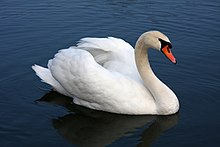Mute swan
| Mute swan | |
|---|---|
 |
|
| Scientific classification | |
| Kingdom: | Animalia |
| Phylum: | Chordata |
| Class: | Aves |
| Order: | Anseriformes |
| Family: | Anatidae |
| Genus: | Cygnus |
| Species: | C. olor |
| Binomial name | |
|
Cygnus olor (Gmelin, 1789) |
|
 |
|
| Global range Year-Round Range Summer Range Winter Range | |
| Synonyms | |
|
|
The mute swan (Cygnus olor) is a species of swan and a member of the waterfowl family Anatidae. It is native to much of Eurasia, and (as a rare winter visitor) the far north of Africa. It is an introduced species in North America, Australasia and southern Africa. The name 'mute' derives from it being less vocal than other swan species. Measuring 125 to 170 cm (49 to 67 in) in length, this large swan is wholly white in plumage with an orange beak bordered with black. It is recognisable by its pronounced knob atop the beak, which is larger in males.
The mute swan was first formally described by the German naturalist Johann Friedrich Gmelin as Anas olor in 1789, and was transferred by Johann Matthäus Bechstein to the new genus Cygnus in 1803. It is the type species of the genus Cygnus. Both cygnus and olor mean "swan" in Latin; cygnus is a variant form of cycnus, a borrowing from Greek κύκνος kyknos, a word of the same meaning.
Despite its Eurasian origin, its closest relatives are the black swan of Australia and the black-necked swan of South America, not the other Northern Hemisphere swans. The species is monotypic with no living subspecies.
Mute swan subfossils, 6,000 years old, have been found in post-glacial peat beds of East Anglia, Great Britain. They have been recorded from Ireland east to Portugal and Italy, and from France, 13,000 BP (Desbrosse and Mourer-Chauvire 1972–1973). The paleosubspecies Cygnus olor bergmanni, which differed only in size from the living bird, is known from fossils found in Azerbaijan.
...
Wikipedia

